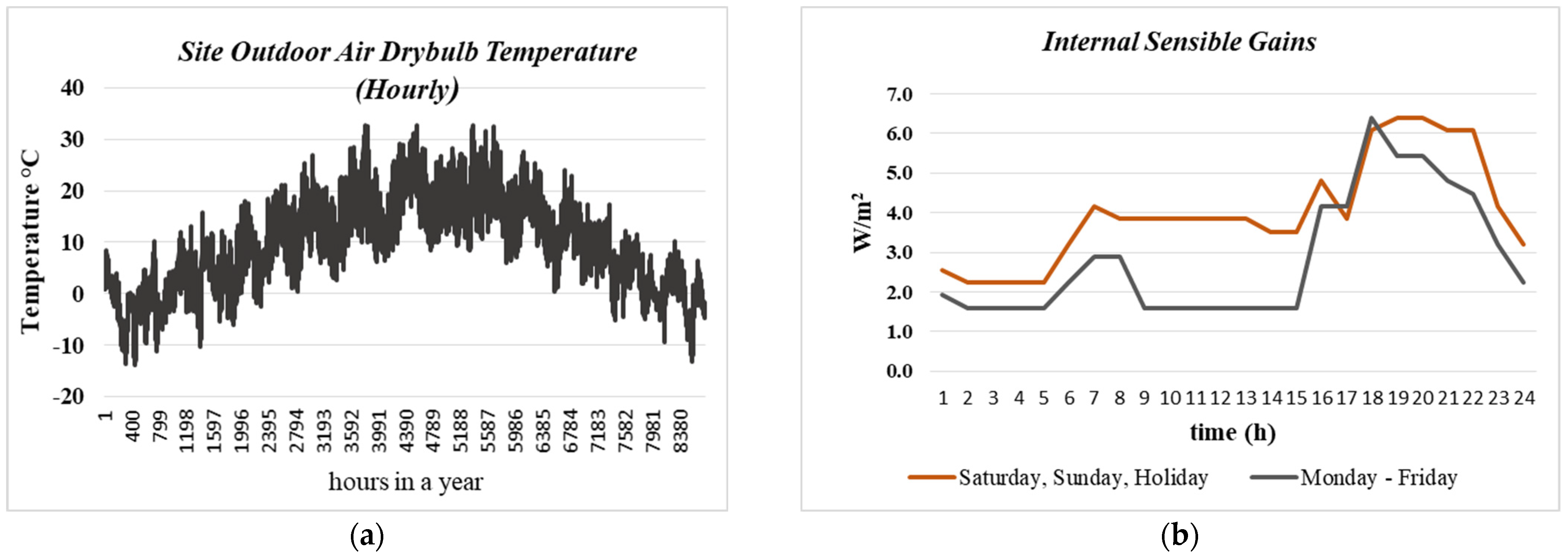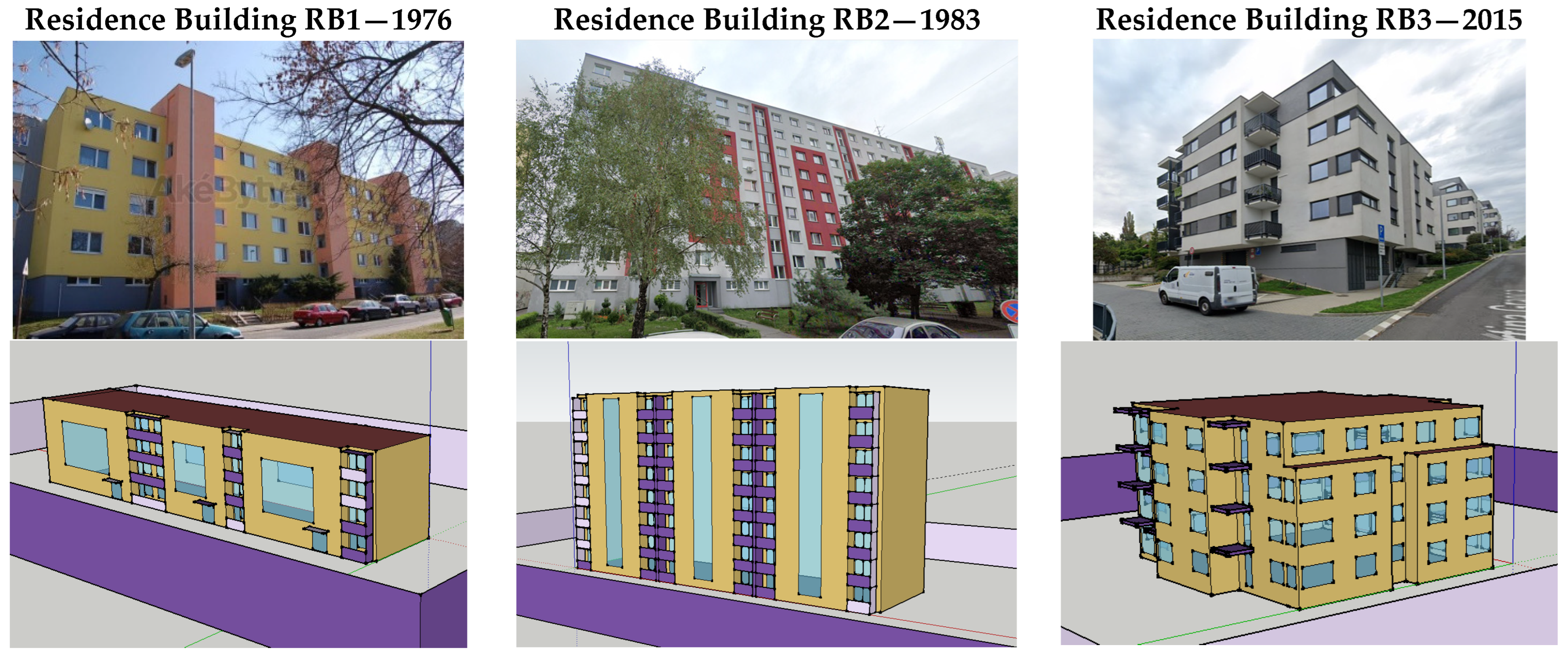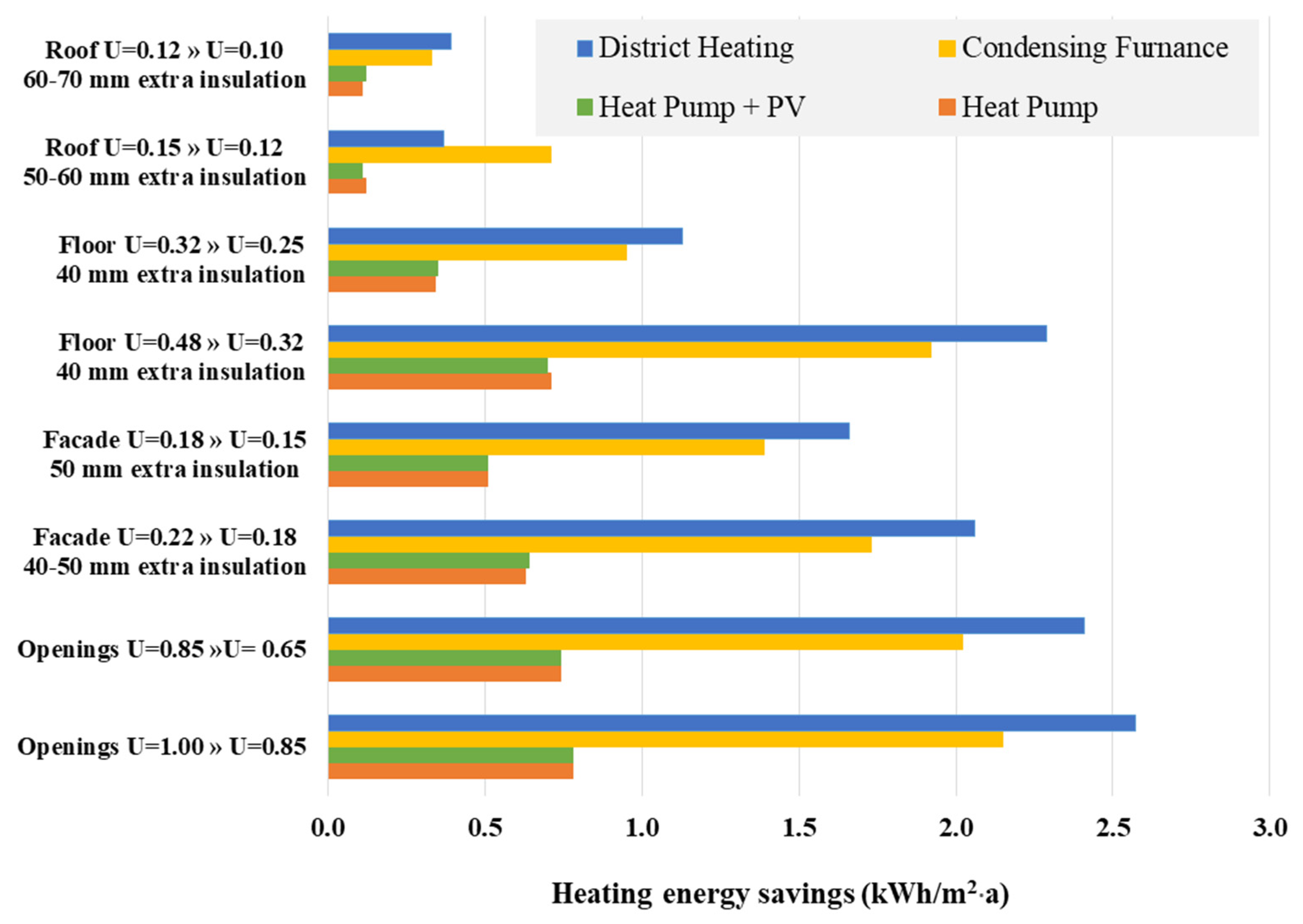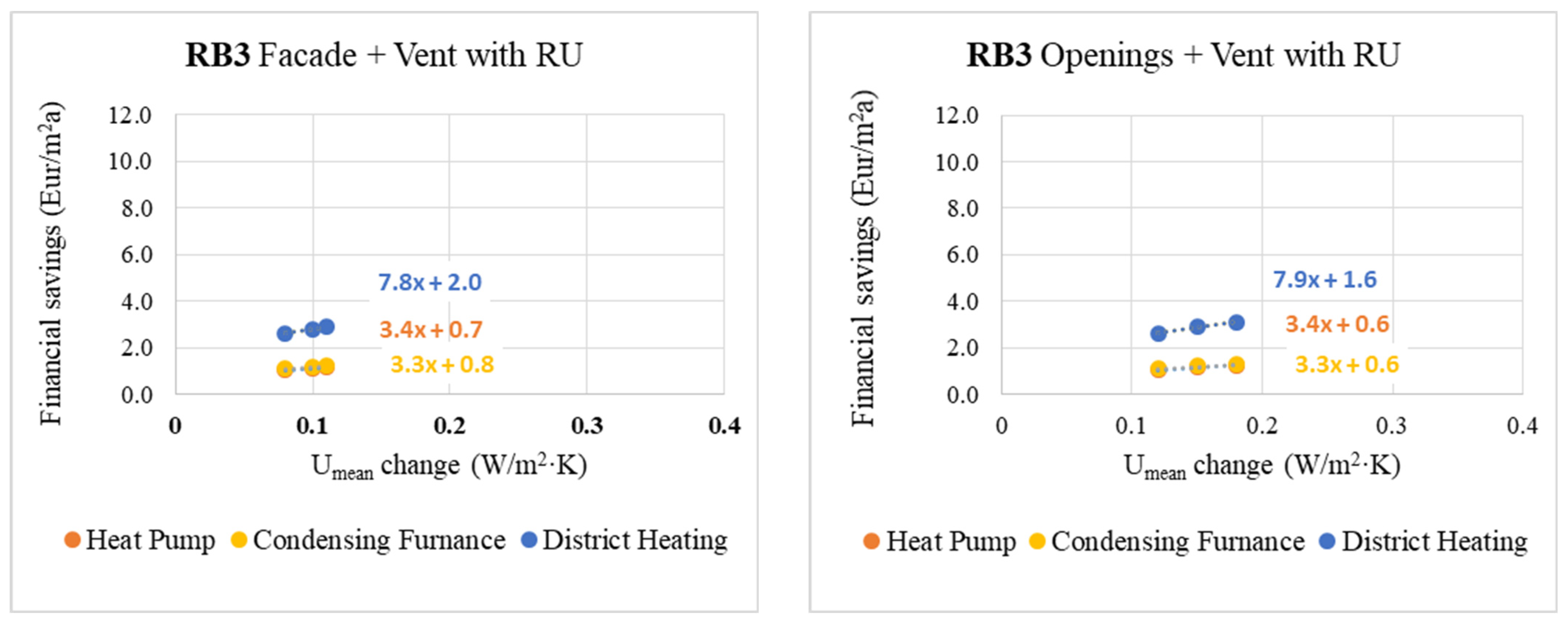Evaluation of Residential Buildings Savings for Various Envelope Retrofits and Heating Energy Sources: A Simulation Study
Abstract
1. Introduction
2. Materials and Methods
2.1. Boundary Conditions
2.2. Building Models
2.3. Variations of Structure Thermal Retrofit
2.4. Variations of Heating Source
- Temperature gradient of heating water in the heating system: 60/40 °C;
- Heat pump heating factor COP: 3;
- Efficiency of the gas-condensing boiler 100%;
- CHP pipeline losses: 7.5%;
- Efficiency of the CHP gas heat source: 90%;
- Photovoltaic power plant—output: 10 kWp;
- Number of photovoltaic panels: 22;
- Slope of photovoltaic panels: 15°.
2.5. Mean U-Value
3. Results and Discussion
3.1. Thermal Retrofitting for Achieving Low-Energy Values
3.2. Savings after Secondary Thermal Retrofitting
3.3. Heating Cost Savings
4. Conclusions
- For semi-old apartment buildings built in Slovakia during the 1970s and 1980s, the most effective retrofit action to reduce the energy needed for heating is still the retrofitting of the facade, rather than the roof, the floors above the unheated floor or the replacement of windows. These results are in line with a similar study carried out by the Bulgarian authorities [37].
- In a sample of a recently constructed apartment building, it was found that the insulation of any structure on the envelope had approximately the same effect on heating energy. However, due to the use of bricks with a higher thermal resistance value, adding extra insulation of the same thickness to the facade is not the most effective action to reduce heating energy, but all retrofit actions are probably almost equally effective. As building construction in the new millennium is governed by stricter standards, this conclusion confirms that the set criteria for envelope structure thermal properties were optimally established, leaving no gaps. Thus, there are no building structures that would remain undervalued and would need to be addressed urgently.
- From a construction technology perspective, it is common to replace windows before or simultaneously with a facade thermal retrofit. According to calculations, it is advantageous to replace windows to the highest possible level (in this case, U = 0.65 W/(m2·K)) for future savings. Further reducing the thermal conductivity of the facade below the low-energy level (less than U = 0.22 W/(m2·K)) may not be as effective as a deeper thermal retrofit of the floor above the unheated basement.
- A single action such as adding extra thermal insulation to the roof with satisfactory thermal resistance (to meet low-energy level requirements), in an apartment building heated by a heat pump, has a minimal impact on energy savings. In this case, the savings were less than 0.30 kWh/m2 per year.
- When adding extra insulation to already insulated apartment buildings, it is important to select a unique strategy based on the building’s heating source. For semi-old apartment buildings that are connected to a district heating supply or heated by gas boilers, retrofitting the facade during the simultaneous replacement of windows appears to be particularly advantageous. If the heating source is a heat pump, retrofitting the building envelope structures will result in minimal energy savings. It cannot be assumed that the owners of these buildings would be motivated to save energy for heating in this way, apart from the danger of high electricity prices. It has already been indicated for 10 years [38] that, in Germany, which is often considered a leader in building efficiency policy, the annual rate and average depth of thermal retrofit actions were significantly lower than expected. The authors suggest that, if improving the efficiency of existing buildings remains voluntary, policies need to change. More targeted retrofitting instructions that suit specific buildings will be necessary.
Author Contributions
Funding
Data Availability Statement
Conflicts of Interest
References
- Odyssee-Mure Project. Energy Efficiency Trends for Households in the EU. 2020. Available online: https://www.odyssee-mure.eu/publications/efficiency-by-sector/households/ (accessed on 20 December 2023).
- European Commission. A Roadmap for Moving to a Competitive Low Carbon Economy in 2050; European Commission: Brussels, Belgium, 2011; Available online: https://eur-lex.europa.eu/LexUriServ/LexUriServ.do?uri=COM:2011:0112:FIN:en:PDF (accessed on 1 November 2023).
- Economidou, M.; Atanasiu, B.; Despret, C.; Maio, J.; Nolte, I.; Rapf, O.; Laustsen, J.; Ruyssevelt, P.; Staniaszek, D.; Strong, D.; et al. Europe’s Buildings under the Microscope: A Country-by-Country Review of the Energy Performance of Buildings, 1st ed.; Building Performance Institute Europe: Brussels, Belgium, 2011; p. 30. [Google Scholar]
- Esser, A.; Dunne, A.; Meeusen, T.; Quaschning, S.; Wegge, D. Comprehensive Study of Building Energy Renovation Activities and the Uptake of Nearly Zero-Energy Buildings in the EU; European Commission: Brussels, Belgium, 2019. [Google Scholar]
- Mainali, B.; Mahapatra, K.; Pardalis, G. Strategies for Deep Renovation Market of Detached Houses. Renew. Sustain. Energy Rev. 2021, 138, 110659. [Google Scholar] [CrossRef]
- Pernetti, R.; Pinotti, R.; Lollini, R. Repository of Deep Renovation Packages Based on Industrialized Solutions: Definition and Application. Sustainability 2021, 13, 6412. [Google Scholar] [CrossRef]
- Ascione, F.; Bianco, N.; De Masi, R.F.; Mauro, G.M.; Vanoli, G.P. Cost-effective refurbishment of Italian historic buildings. In Cost-Effective Energy Efficient Building Retrofitting: Materials, Technologies, Optimization and Case Studies; Elsevier Inc.: Amsterdam, The Netherlands, 2017; pp. 553–596. [Google Scholar] [CrossRef]
- Zanni, J.; Cademartori, S.; Marini, A.; Belleri, A.; Passoni, C.; Giuriani, E.; Riva, P.; Angi, B.; Brumana, G.; Marchetti, A.L. Integrated Deep Renovation of Existing Buildings with Prefabricated Shell Exoskeleton. Sustainability 2021, 13, 11287. [Google Scholar] [CrossRef]
- Tirelli, D.; Besana, D. Moving toward Net Zero Carbon Buildings to Face Global Warming: A Narrative Review. Buildings 2023, 13, 684. [Google Scholar] [CrossRef]
- Ohene, E.; Chan, A.P.C.; Darko, A. Prioritizing barriers and developing mitigation strategies toward net-zero carbon building sector. Build. Environ. 2022, 223, 109437. [Google Scholar] [CrossRef]
- Singh, R.; Walsh, P.; Mazza, C. Sustainable Housing: Understanding the Barriers to Adopting Net Zero Energy Homes in Ontario, Canada. Sustainability 2019, 11, 6236. [Google Scholar] [CrossRef]
- Pan, W.; Pan, M. Drivers, barriers and strategies for zero carbon buildings in high- rise high-density cities. Energy Build. 2021, 242, 110970. [Google Scholar] [CrossRef]
- Heffernan, E.; Pan, W.; Liang, X.; De Wilde, P. Zero carbon homes: Perceptions from the UK construction industry. Energy Policy 2015, 79, 23–36. [Google Scholar] [CrossRef]
- Longo, S.; Montana, F.; Riva Sanseverino, E. A review on optimization and cost-optimal methodologies in low-energy buildings design and environmental considerations. Sustain. Cities Soc. 2019, 45, 87–104. [Google Scholar] [CrossRef]
- Long-Term Strategy for the Renewal of the Building Stock Ministry of Transport and Construction. 2020. Available online: https://energy.ec.europa.eu/system/files/2021-02/sk_2020_ltrs_0.pdf (accessed on 20 December 2023).
- Fernandez-Antolin, M.-M.; del Río, J.M.; Costanzo, V.; Nocera, F.; Gonzalez-Lezcano, R.-A. Passive Design Strategies for Residential Buildings in Different Spanish Climate Zones. Sustainability 2019, 11, 4816. [Google Scholar] [CrossRef]
- Summa, S.; Remia, G.; Sebastianelli, A.; Coccia, G.; Di Perna, C. Impact on Thermal Energy Needs Caused by the Use of Different Solar Irradiance Decomposition and Transposition Models: Application of EN ISO 52016-1 and EN ISO 52010-1 Standards for Five European Cities. Energies 2022, 15, 8904. [Google Scholar] [CrossRef]
- Bianco, F.; Degerfeld, M.; Ballarini, I.; De Luca, G.; Mamak, P. Sensitivity Analysis of the Thermal Energy Need of a Residential Building Assessed by means of the EN ISO 52016 Simplified Dynamic Method. E3S Web. Conf. 2020, 197, 02012. [Google Scholar] [CrossRef]
- van Dijk, D.; Kurnitski, J. The EPBD recast: How to come to a transparent and fair ZEB definition? The REHVA European HVAC J. 2022, 4, 10–15. [Google Scholar]
- EN ISO 52016-1:2017; Energy Performance of Buildings—Energy Needs for Heating and Cooling, Internal Temperatures and Sensible and Latent Head Loads—Part 1: Calculation Procedures Performance. European Committee for Standardization: Brussels, Belgium, 2017.
- van Dijk, D. EPB standards: Why choose hourly calculation procedures? REHVA Eur. HVAC J. 2018, 55, 6–12. [Google Scholar]
- Di Giuseppe, E.; Ulpiani, G.; Summa, S.; Tarabelli, L.; Di Perna, C.; D’Orazio, M. Hourly dynamic and monthly semi-stationary calculation methods applied to nZEBs: Impacts on energy and comfort. IOP Conf. Ser. Mater. Sci. Eng. 2019, 609, 072008. [Google Scholar] [CrossRef]
- Vertal, M.; Zozulák, M.; Vašková, A.; Korjenic, A. Hygrothermal initial condition for simulation process of green building construction. Energy Build. 2018, 167, 166–176. [Google Scholar] [CrossRef]
- Juras, P.; Jurasova, D. Outdoor Climate Change Analysis in University Campus: Case Study with Heat-Air-Moisture Simulation. Civ. Environ. Eng. 2020, 16, 370–378. [Google Scholar] [CrossRef]
- Dréau, J.L.; Heiselberg, P. Energy flexibility of residential buildings using short term heat storage in the thermal mass. Energy 2016, 111, 991–1002. [Google Scholar] [CrossRef]
- Wiekiera, R. Technical and Economic Analysis of the Use of Heat Pumps in a Public Facility. Civ. Environ. Eng. Rep. 2022, 32, 376–388. [Google Scholar] [CrossRef]
- Carlander, J.; Trygg, K.; Moshfegh, B. Integration of measurements and time diaries as complementary measures to improve resolution of BES. Energies 2019, 12, 2072. [Google Scholar] [CrossRef]
- Rakha, T.; Rose, C.; Reinhart, C. A framework for modeling occupancy schedules and local trips based on activity based surveys. In Proceedings of the 2014 ASHRAE/IBPSA-USA Building Simulation Conference, Atlanta, GA, USA, 10–12 September 2014. [Google Scholar]
- Andersen, F.M.; Baldini, M.; Hansen, L.G.; Jensen, C.L. Households’ hourly electricity consumption and peak demand in Denmark. Appl. Energy 2017, 208, 607–619. [Google Scholar] [CrossRef]
- Crawley, D.B.; Lawrie, L.K.; Winkelmann, F.C.; Buhl, W.F.; Huang, Y.J.; Pedersen, C.O.; Strand, R.K.; Liesen, R.J.; Fisher, D.E.; Witte, M.J. EnergyPlus: Creating a new-generation building energy simulation program. Energy Build. 2001, 33, 319–331. [Google Scholar] [CrossRef]
- Slovak Technical Standards (STN) 73 0540-2/Z1 + Z2: 2019, Properties of Environment and Building Products-Parts 3: Thermal Performance of Buildings and Constructions. Thermal Protection of Buildings. Slovak Office of Standards, Metrology and Testing. Available online: https://www.unms.sk/?home (accessed on 25 November 2023).
- The Act. No. 555/2005 on the Energy Performance of Buildings and on the Amendments to Certain Laws Ministry of Transport and Construction of the Slovak Republic. Available online: https://www.slov-lex.sk/pravne-predpisy/SK/ZZ/2005/555/vyhlasene_znenie.html (accessed on 5 January 2024).
- Slovak Ministry of Internal Affairs and Communications, Decree of ministry of Internal Affairs and Communications No. 324 /2016. Available online: https://www.slov-lex.sk (accessed on 25 November 2023).
- EN 15316-4-3:2014; Heating Systems in Buildings—Method for Calculation of System Energy Requirements and System Efficiencies. European Committee for Standardization: Brussels, Belgium, 2017.
- STN EN ISO 13790/NA/Z1; Energy Performance of Buildings. Calculation of Energy Use for Space Heating and Cooling (ISO 13790:2008). (Energetická Hospodárnosť Budov. Výpočet Potreby Energie na Vykurovanie a Chladenie (ISO 13790: 2008). Slovak Office of Standards, Metrology and Testing: Bratislava, Slovakia, 2012.
- Buday, P.; Ingeli, R.; Vavrovič, B. Comparison of Thermal Bridges Calculate Method through Typical Details in Low Energy Designing. Adv. Mater. Res. 2013, 855, 126–129. [Google Scholar] [CrossRef]
- Doseva, N.; Chakyrova, D. Life Cycle Cost Optimization of Residential Buildings in Bulgaria: A Case Study of the Building Envelope. Civ. Environ. Eng. 2021, 17, 107–116. [Google Scholar] [CrossRef]
- Galvin, R. Why German homeowners are reluctant to retrofit. Build. Res. Inf. 2014, 42, 398–408. [Google Scholar] [CrossRef]








| Abbreviation | Referred to |
|---|---|
| nZEB | Nearly Zero Energy Demand Building |
| TMY | Test Meteorological Year |
| RB1 | Residential Building Built in 1976 |
| RB2 | Residential Building Built in 1983 |
| RB3 | Residential Building Built in 2015 |
| U-value | Heat Transfer Coefficient Value |
| SHGC | Solar Heat Gain Coefficient |
| RU | Heat Recovery Unit |
| COP | Coefficient of Heat Pump Performance |
| CHP | Combined Heat and Power System |
| PV | Photovoltaic Power System |
| Residence Building RB1 | ||
| Parameter | Value | Units |
| Conditioned space floor area | 2330.7 | m2 |
| Energy demand before modernization | 133.2 | kWh/(m2·a) |
| External walls U-value | 1.49 | W/(m2·K) |
| Roof U-value | 1.0 | W/(m2·K) |
| Floor U-value | 1.75 | W/(m2·K) |
| Window U-value without shading system | 2.7 | W/(m2·K) |
| Window with shading system SHGC | 45 | % |
| Window/floor area | 16.3 | % |
| Infiltration | 0.68 | 1/h |
| Residence Building RB2 | ||
| Parameter | Value | Units |
| Conditioned space floor area | 4228.4 | m2 |
| Energy demand before modernization | 90.1 | kWh/(m2·a) |
| External walls U-value | 1.0 | W/(m2·K) |
| Roof U-value | 0.6 | W/(m2·K) |
| Floor U-value | 1.88 | W/(m2·K) |
| Window U-value without shading system | 2.7 | W/(m2·K) |
| Window with shading system SHGC | 45 | % |
| Window/floor area | 15.4 | % |
| Infiltration | 0.79 | 1/h |
| Residence Building RB3 | ||
| Parameter | Value | Units |
| Conditioned space floor area | 1750.0 | m2 |
| Energy demand before modernization | 42.9 | kWh/(m2·a) |
| External walls U-value | 0.32 | W/(m2·K) |
| Roof U-value | 0.2 | W/(m2·K) |
| Floor U-value | 0.61 | W/(m2·K) |
| Window U-value without shading system | 1.4 | W/(m2·K) |
| Window with shading system SHGC | 40 | % |
| Window/floor area | 21.1 | % |
| Infiltration | 0.5 | 1/h |
| Residence Building RB1 | VB1 | VB2 | VB3 | VC1 | VC2 | VC3 | VD1 | VD2 | VD3 | VE1 | VE2 | VE3 |
| External walls insulation | 160 mm | 200 mm | 250 mm | initial s. | initial s. | initial s. | initial s. | initial s. | initial s. | initial s. | initial s. | initial s. |
| Roof insulation | initial s. | initial s. | initial s. | 200 mm | 250 mm | 320 mm | initial s. | initial s. | initial s. | initial s. | initial s. | initial s. |
| Floor insulation | initial s. | initial s. | initial s. | initial s. | initial s. | initial s. | 60 mm | 100 mm | 140 mm | initial s. | initial s. | initial s. |
| Windows replacement | initial s. | initial s. | initial s. | initial s. | initial s. | initial s. | initial s. | initial s. | initial s. | Triple U = 1.0 | Triple U = 0.85 | Triple U = 0.65 |
| Ventilation | Mechanical ventilation with heat recovery unit—flow rate 1680 m3/h, efficiency 78.4% | |||||||||||
| Residence Building RB2 | VB1 | VB2 | VB3 | VC1 | VC2 | VC3 | VD1 | VD2 | VD3 | VE1 | VE2 | VE3 |
| External walls insulation | 150 mm | 200 mm | 250 mm | initial s. | initial s. | initial s. | initial s. | initial s. | initial s. | initial s. | initial s. | initial s. |
| Roof insulation | initial s. | initial s. | initial s. | 180 mm | 230 mm | 300 mm | initial s. | initial s. | initial s. | initial s. | initial s. | initial s. |
| Floor insulation | initial s. | initial s. | initial s. | initial s. | initial s. | initial s. | 60 mm | 100 mm | 140 mm | initial s. | initial s. | initial s. |
| Windows replacement | initial s. | initial s. | initial s. | initial s. | initial s. | initial s. | initial s. | initial s. | initial s. | Triple U = 1.0 | Triple U = 0.85 | Triple U = 0.65 |
| Ventilation | Mechanical ventilation with heat recovery unit—flow rate 2690 m3/h, efficiency 78.4% | |||||||||||
| Residence Building RB3 | VB1 | VB2 | VB3 | VC1 | VC2 | VC3 | VD1 | VD2 | VD3 | VE1 | VE2 | VE3 |
| External walls insulation | 60 mm | 100 mm | 150 mm | initial s. | initial s. | initial s. | initial s. | initial s. | initial s. | initial s. | initial s. | initial s. |
| Roof insulation | initial s. | initial s. | initial s. | 60 mm | 120 mm | 180 mm | initial s. | initial s. | initial s. | initial s. | initial s. | initial s. |
| Floor insulation | initial s. | initial s. | initial s. | initial s. | initial s. | initial s. | 20 mm | 60 mm | 100 mm | initial s. | initial s. | initial s. |
| Windows replacement | initial s. | initial s. | initial s. | initial s. | initial s. | initial s. | initial s. | initial s. | initial s. | Triple U = 1.0 | Triple U = 0.85 | Triple U = 0.65 |
| Ventilation | Mechanical ventilation with heat recovery unit—flow rate 1275 m3/h, efficiency 78.4% | |||||||||||
Disclaimer/Publisher’s Note: The statements, opinions and data contained in all publications are solely those of the individual author(s) and contributor(s) and not of MDPI and/or the editor(s). MDPI and/or the editor(s) disclaim responsibility for any injury to people or property resulting from any ideas, methods, instructions or products referred to in the content. |
© 2024 by the authors. Licensee MDPI, Basel, Switzerland. This article is an open access article distributed under the terms and conditions of the Creative Commons Attribution (CC BY) license (https://creativecommons.org/licenses/by/4.0/).
Share and Cite
Ponechal, R.; Jandačka, J.; Ďurica, P. Evaluation of Residential Buildings Savings for Various Envelope Retrofits and Heating Energy Sources: A Simulation Study. Buildings 2024, 14, 332. https://doi.org/10.3390/buildings14020332
Ponechal R, Jandačka J, Ďurica P. Evaluation of Residential Buildings Savings for Various Envelope Retrofits and Heating Energy Sources: A Simulation Study. Buildings. 2024; 14(2):332. https://doi.org/10.3390/buildings14020332
Chicago/Turabian StylePonechal, Radoslav, Jozef Jandačka, and Pavol Ďurica. 2024. "Evaluation of Residential Buildings Savings for Various Envelope Retrofits and Heating Energy Sources: A Simulation Study" Buildings 14, no. 2: 332. https://doi.org/10.3390/buildings14020332
APA StylePonechal, R., Jandačka, J., & Ďurica, P. (2024). Evaluation of Residential Buildings Savings for Various Envelope Retrofits and Heating Energy Sources: A Simulation Study. Buildings, 14(2), 332. https://doi.org/10.3390/buildings14020332






